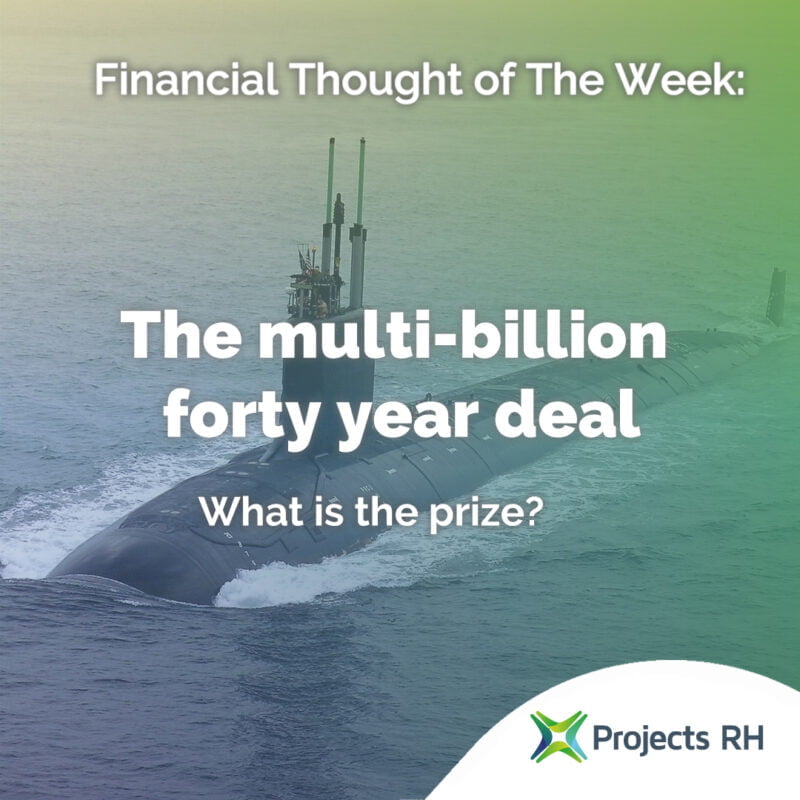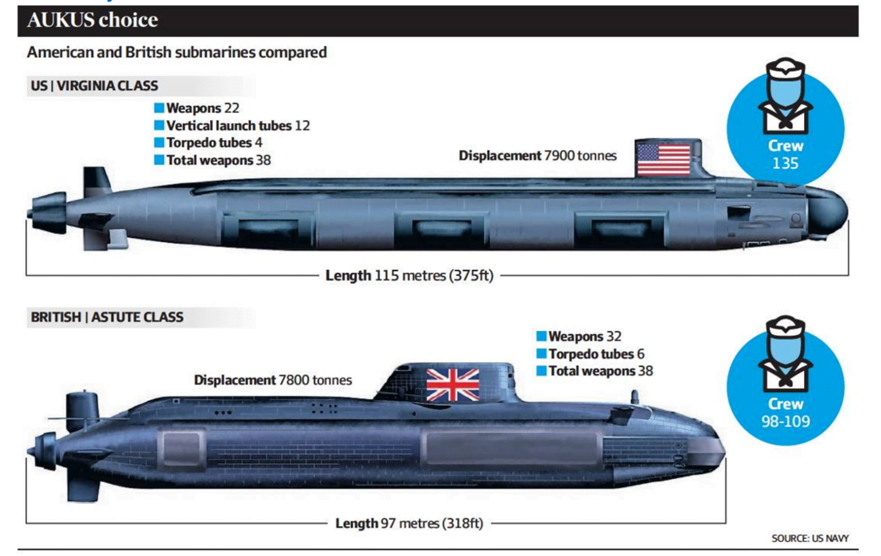Nuclear Subs: The Prize is Technology Transfer
Nuclear Subs: The Prize is Technology Transfer

Recent Posts
How to fundraise for a Nonprofit: Best strategies for success
How do I find investors? The ultimate guide
What is an Investment Teaser?
Information memorandum: A comprehensive guide
What is a pitch deck? Complete guide to a winning presentation
The multi billion 40 year deal
Australia will buy from the US Government five Virginia class nuclear submarines in the near decade and then will commence building a British design vessel in Australia. It is understood that much of the interior of this vessel will be supplied by the United States. This is a bi-partisan decision to lock US, UK and Australia into much more than a military hardware supply arrangement.[1] It is a 40 year strategic deal. Construction alone is an AUD 70-78 billion in today’s money decision. The real lock in is in training and technology transfer.
Anyone who has traveled to Australia knows it’s a long way from nearly anywhere else and has the largest coastline of any country.
Like many nations, Australia is always concerned about its security and has worried for more than two centuries about its distance from allies and suppliers.
The critical part about the announcement is Australia will be only one of seven countries with nuclear technology to power submarines. The fact that the second-generation of nuclear submarines are to be built, maintained, and housed in Australia necessitates a vast investment across a range of STEM related disciplines. It will ensure jobs for young technologists for decades without them needing to leave Australia.[2] These jobs will be diverse and geographically distant with naval bases being developed on both the east and west coast of Australia and the manufacturing facility being in 2030’s.
The best defense…
The core reason for the decision to buy nuclear submarines, with their long-range, is clearly self-defense. Australia has long considered having a blue water navy is critical to its future survival as it is at its heart a trading country and has never planned to live in isolation.
Given its large geography and small population Australia has always sought to have and maintain powerful allies and friends which share is cultural and economic aspirations. Australia is a liberal democracy with its base in Asia but with strong historic and military ties to the US, UK and what is called the Western alliance. It is a member of the five eyes group and hosts joint satellite and military assets for the US and the UK already.
The decision to replace the Collins class submarines it is a mix of technology, functionality, and range. In short, the Collins class submarines of the Australian Navy are high maintenance, lack range and no longer meet the defense needs of country. The purpose of these ships is defensive. Australia is in no position to play aggressor in its region let alone across the globe.
This decision is hugely expensive for Australia. It will come at the price of other things not only militarily but within our community. One of the clear opportunities for Australians will be to work and study in the industry in the United States and United Kingdom. This will build a body of knowledge and skills which are applicable not just to submarines, across the board and stimulate STEM industries in Australia.[3]
A political statment
This submarine program will not see Australia armed with its own nuclear submarines in the foreseeable future. In one sense the whole AUKUS alliance is a political statement. Yes, the deep concern is about varying political aspirations around the planet and that Australia needs play its part. Australia will not buy its first secondhand Virginia class submarines until the 2030s. Hopefully, by that time political tensions will have return to normal. In the year 2027 there will be US submarines permanently stationed in Australia. Australia will not have the capacity to build its nuclear own submarines, modeled on the British Astute Class, in South Australia until the end of that decade.[5]
For each of the above Australia needs to get into shape. There is a demand for nuclear physicists but also marine engineers. First, Australia will need to host US submarines and take the role in the building of its own but in the United States. The program will result in more than 10,000 new jobs to build operate and maintain Australia’s new submarines plus those of visitors.[6]
The submarines Australia will build for itself will be the same as the British design but will have American technology.
Australia will make a capital investment production of nuclear submarines in the United States allowing for the capacity to exist to build some submarines for it.
Today submarines are expensive
The owning, building, and operating of nuclear submarines is expensive. For Australia is a necessary defense capacity to ensure that the population feel protected. Secondly it is an important part of our contribution to our various alliances specifically those involving USA, UK, New Zealand, Japan and of increasing importance India. For Australia, what is critical is to keep open the sea lanes and show we are committed to peace in our region.
It is a political in Australia that we should develop as much capacity in-house as possible. On purely rational economic grounds, Australia developing and maintaining a shipbuilding industry frankly does not make much sense. When you layer on top of this security and technology transfer, the scale balances towards we need this industry in the view of most Australians. Today’s Australian industry does not manufacture low value goods but is focused on high-value production which by its very nature is technology-driven. Carrying universities and colleges which train and retrain people in this level of marine technology will ensure Australia has the technologists, engineers, scientists, and mathematicians it needs to be a leader and smart technologies. Given Australia’s high costs and geographic position it needs to focus on value-added technologies. In short, a self-managed nuclear submarine program will see a technology transfer which can be mirrored into other things undertaken by the Australian economy.
There is debate that in selecting first to receive five Virginia class submarines and then build five Astute class submarines will result unnecessary duplication. At this point it’s too early to tell. A replacement is necessary for the Collins class submarines by 2038. That is something that cannot be delayed.
The economics in the defense
What on the face of it looks like a defense decision is very much an economics decision. Australia will receive and continue to receive technology which it would not otherwise have had and was made clear from the space program there are lots of incidental technologies that spin-off from having a call focused capacity as well as technology. Australia’s decision is expensive, but the program chosen will give Australians a reassurance of their security. It will also ensure that Australia can continue to make a meaningful contribution to its strategic defense alliances.
The prize belongs to those Australians of 2030 and beyond who look at the jobs they and their peers have, which would not exist otherwise but for this brave decision to engage in a technology in the national interest but a great cost. The manufacturing capacity and the intellectual development will find its way into other industries and assist Australia to the value-added business.
This is a great significance to not only the manufacturing but the education sector as it will ensure that Australia has a technical edge.
The greatest benefit however lies in the fact that it is bipartisan and will not be overturned and will keep Australia’s place in the world.
By Paul Raftery – CEO, Projects RH, based in Sydney
If you have any former questions, please call +61 418 486 015.
———————————–
[1] Kelly, P.; “Deep Dive Into Unknown Waters”, The Weekend Australian, 11-12 March, 2023, p. 17
[2] “A University of NSW study this week found that Australia must train at least 108 PhD-level researchers in nuclear engineering every year to operate and maintain its future nuclear-powered submarines. In addition, Australia would need 2635 “mid-tier” nuclear professionals and 3010 “nuclear-aware” workers. At present the nation’s only nuclear engineering program at UNSW has 53 postgraduates and 74 undergraduates.” Published in Hewett, C.; “High Reward but High Risk”, The Weekend Australian, 11 March, 2023, p.22
[3] Coorey, P.; Nuclear subs for peace, not war: Marles, Dutton”, The Australian Financial Review, 3/10/2023.
[4] Source: McIIroy, T.; “‘Apex predator of the ocean’ to enhance our naval capability”, The Australian Financial Review, 3/10/2023.
[5] Tillett, A.; “US nuclear subs for AUKUS gap”, The Australian Financial Review, 3/10/2023.
[6] Source: McIIroy, T.; “‘Apex predator of the ocean’ to enhance our naval capability”, The Australian Financial Review, 3/10/2023.







